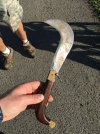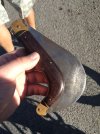-
The BladeForums.com 2024 Traditional Knife is available! Price is $250 ea (shipped within CONUS).
Order here: https://www.bladeforums.com/help/2024-traditional/
You are using an out of date browser. It may not display this or other websites correctly.
You should upgrade or use an alternative browser.
You should upgrade or use an alternative browser.
Unusual Knife
- Thread starter CBurgett
- Start date
There are a few different knives like that. One is a grape harvesting knife (that one looks Italian to me). They are also used for various other gardening/farming activities involving vegetation (pruning, etc). Look the blade over really carefully for a country of origin stamp, sometimes they can be really small or faint.
And then there is the "Saca Tripas" (a few pictured below), a Mexican agricultural knife that was also often used as a fighting knife. "Saca Tripas" means -to disembowel. Fun times in old Mexico .
.
But the one you pictured is purely for agricultural use like jfk1110 said. I included the Saca Tripas because it's similar, and because it has a colorful history .
.


And then there is the "Saca Tripas" (a few pictured below), a Mexican agricultural knife that was also often used as a fighting knife. "Saca Tripas" means -to disembowel. Fun times in old Mexico
But the one you pictured is purely for agricultural use like jfk1110 said. I included the Saca Tripas because it's similar, and because it has a colorful history


Last edited:
- Joined
- Jun 10, 2024
- Messages
- 1,073
Some kind of billhook knife. Never seen one as a folder. Just guessing but I second the thought of it being for grape harvesting.
Looking around the internet I see that identical ones were made in Italy for at least two different companies, Whitby (the UK) and Hoffritz (USA), and marked as such. I read that the Whitby ones were made by Mauro Mario in Maniago (Italy). Mauro Mario is also famous for making switchblades. It wouldn't surprise me if MM made all of the ones like it.
I also saw identical ones without any identifiable markings.
They are frequently described as "bill hook" just like Maximumbob referenced.
I also saw identical ones without any identifiable markings.
They are frequently described as "bill hook" just like Maximumbob referenced.
- Joined
- Jun 10, 2024
- Messages
- 1,073
Would the spring bar on it also suggest Italian decent? I don't know how often that is used by anyone else.Mauro Mario in Maniago (Italy)
Would the spring bar on it also suggest Italian decent? I don't know how often that is used by anyone else.
If you're referring to the lever connected to the lock bar (typically referred to as a "fulcrum release"), I can only remember seeing those on Italian and Spanish made knives, as well as some reproductions here in the US.
But I believe the use of a long spring-type back lock, pinned through the handle, has also been used in other countries.
The main reason I believe the knife CBurgett posted is Italian is because I've seen others just like it marked "Italy" or "Made in Italy".
Last edited:


